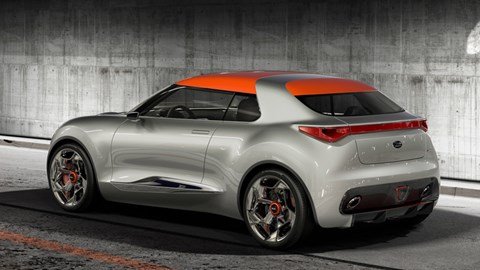Talk me through the Kia Provo’s styling
The body panels are carbonfibre, one of several supercar design traits Kia has pinched for its latest concept car. Note also the ‘visor’ windscreen (thanks, Koenigsegg) slim LED headlights and oversized front splitter.
At the back there’s a single light strip (Porsche 911 Carrera 4, anyone?) and dual exhausts, plus a Ferrari F12-style centre brake light and rear diffuser.
Is the Kia Provo just a no-go show-pony?
Nope. Under the bonnet is the Proceed GT’s turbocharged 1.6-litre petrol engine, good for 197bhp. While that powers the front wheels, the rears are driven by a 43bhp electric motor, charged up during braking or on the overrun. The Provo can ‘creep’ in EV-only stealth mode at urban speeds, or the hybrid drivetrain can act as a full four-wheel drive system for maximum acceleration. The concept car’s transmission is a six-speed dual-clutch ‘box.
What about the Kia Provo’s cabin?
Open the three-piece carbon doors (the flush handles pop out electrically) and you’ll enter a cabin Kia calls ‘very, very black’. Why? Because a dark cabin doesn’t distract from the driving experience, says the Korean automaker. The dashboard is a single piece of carbonfibre, with minimal controls – just a drive selector dial and multimedia interface controller. Kia says it opted for an automatic gearbox to avoid the need for a gearlever cluttering the car’s cabin. Does a gearlever really count as clutter? We digress…
Drivers can select a variety of screen displays: in Normal mode the driver sees a speedometer, rev counter and sat-nav route instructions; in Cruise the display shows a, route instructions and a speedo; and in Track mode the display features just a large rev counter, a track-map and a lap-timer. There’s also an ‘Entertainment’ mode for controlling your music and radio playback. Must be for the yoof market…
The front seats are made from a single leather-quilted panel running from one door sill to the other. The seat backrests don’t fold; instead, they’re mounted on a rotating aluminium track so they spin into the centre of the vehicle allowing easy access to the admittedly occasional-use rear seats.
We've seen a small Kia sports coupe concept before (the Korean company unveiled the cool Kee in 2007) but that came to nothing, so here's hoping the Provo makes the transition from show car to road car.


